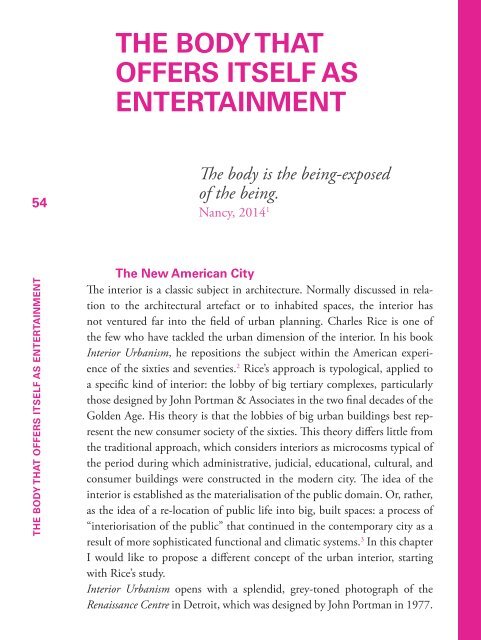Create successful ePaper yourself
Turn your PDF publications into a flip-book with our unique Google optimized e-Paper software.
THE BODY THAT<br />
OFFERS ITSELF AS<br />
ENTERTAINMENT<br />
54<br />
The body is the being‐exposed<br />
of the being.<br />
Nancy, 2014 1<br />
THE BODY THAT OFFERS ITSELF AS ENTERTAINMENT<br />
The New American City<br />
The interior is a classic subject in architecture. Normally discussed in relation<br />
to the architectural artefact or to inhabited spaces, the interior has<br />
not ventured far into the field of urban planning. Charles Rice is one of<br />
the few who have tackled the urban dimension of the interior. In his book<br />
Interior Urbanism, he repositions the subject within the American experience<br />
of the sixties <strong>and</strong> seventies. 2 Rice’s approach is typological, applied to<br />
a specific kind of interior: the lobby of big tertiary complexes, particularly<br />
those designed by John Portman & Associates in the two final decades of the<br />
Golden Age. His theory is that the lobbies of big urban buildings best represent<br />
the new consumer society of the sixties. This theory differs little from<br />
the traditional approach, which considers interiors as microcosms typical of<br />
the period during which administrative, judicial, educational, cultural, <strong>and</strong><br />
consumer buildings were constructed in the modern city. The idea of the<br />
interior is established as the materialisation of the public domain. Or, rather,<br />
as the idea of a re-location of public life into big, built spaces: a process of<br />
“interiorisation of the public” that continued in the contemporary city as a<br />
result of more sophisticated functional <strong>and</strong> climatic systems. 3 In this chapter<br />
I would like to propose a different concept of the urban interior, starting<br />
with Rice’s study.<br />
Interior Urbanism opens with a splendid, grey-toned photograph of the<br />
Renaissance Centre in Detroit, which was designed by John Portman in 1977.


















